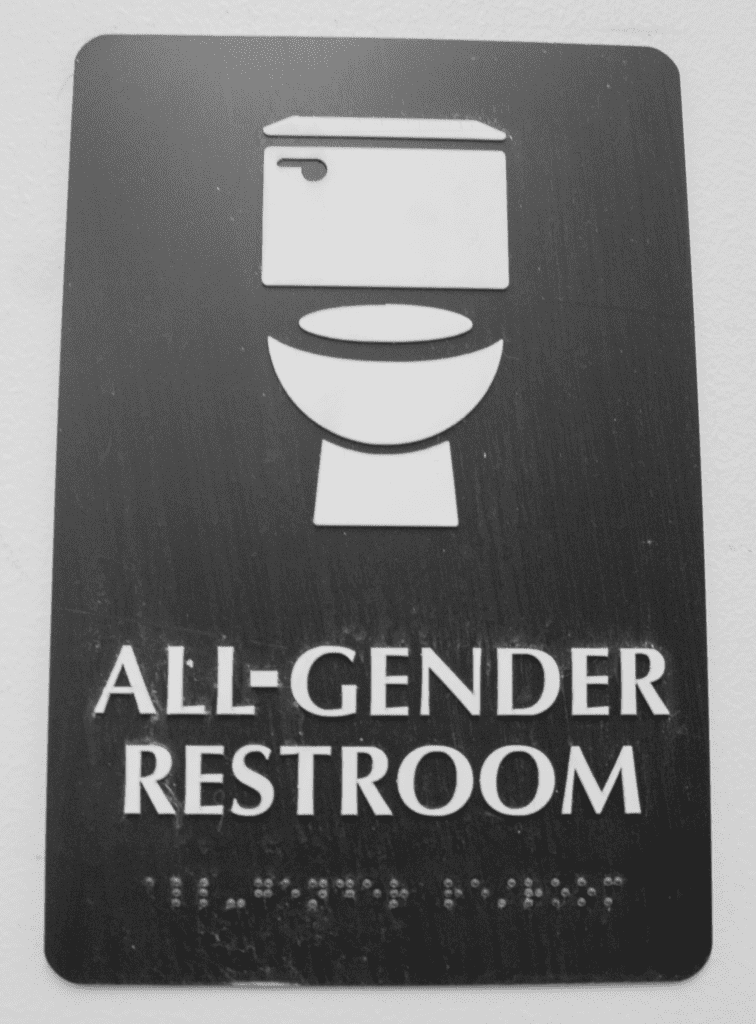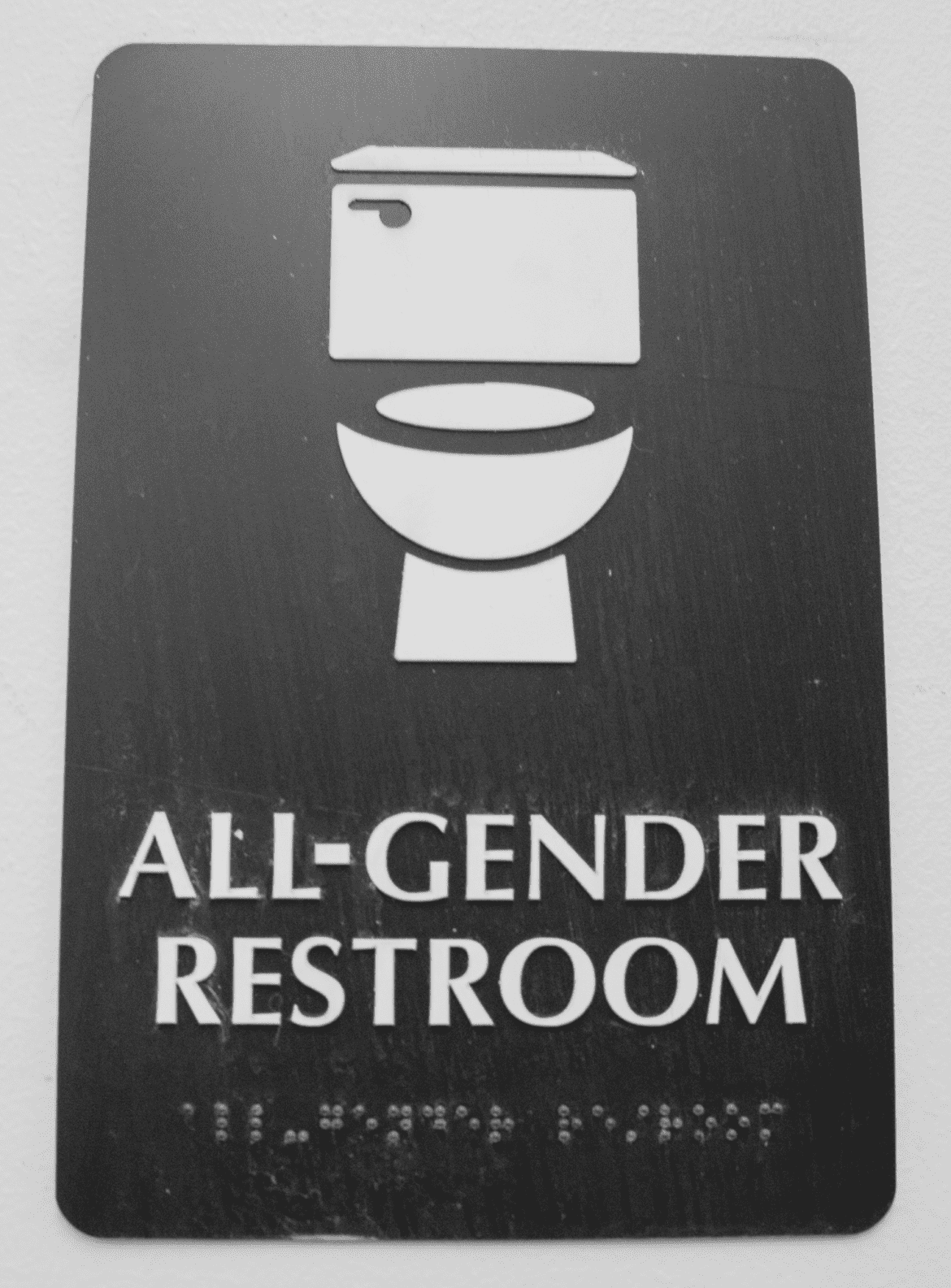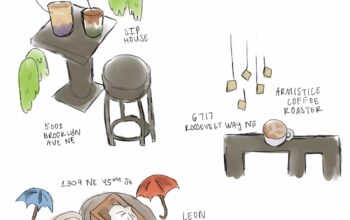
Roosevelt’s all-gender plaque, pictured above
CW: Mention of verbal harassment and sexual and physical assault
Gender-nonconforming individuals insist there should be more all-gender bathrooms at Roosevelt. The frequently occupied and inconveniently located all-gender bathroom on the second floor, and the two adjacent ones on the first, are not enough.
Understanding Key Terminology
According to the Gay, Lesbian, and Straight Education Network (GLSEN), “Transgender people are people whose gender identity is not aligned with the gender they were assigned at birth and/or whose gender doesn’t conform with traditional or societal gender norms,” while cisgender people’s identity aligns with the gender they were assigned at birth.
Transgender people may experience gender dysphoria, which is a form of psychological distress that occurs when one’s sex assigned at birth doesn’t align with one’s gender identity.
The gender binary is a classification system used for most restrooms that consists of two genders, boy and girl. In reality, gender is a spectrum. Non-binary people are those who lie outside of the gender binary or between boy and girl on the gender spectrum.
The Seattle Office for Civil Rights (SOCR) states that Seattle’s All-Gender Restroom Ordinance allows “Use of single occupant restrooms by any person, regardless of sex or gender identity, and prevents those restrooms from being restricted to a specific sex or gender identity,” in public places in the city.
The Issue
While gendered bathrooms pose problems for both trans and non-binary people, the issue is especially prevalent for gender-nonconforming individuals— a term that references people who don’t represent in a way that conforms with cisgender expectations, or gender stereotypes, as phrased by Parents, Families, and Friends of Lesbians and Gays (PFLAG).
Comfort in bathrooms is unique to each individual. Although, it’s likely that if someone’s gender representation aligns with the societal gender constructs of girl and boy, it would be easier to find a bathroom that fits their gender identity. The same cannot be said for gender-nonconforming individuals.
However, it must be recognized that not all trans people present in accordance with cis-based expectations, and are often at varying stages of transition. So, many trans people may not feel comfortable in the gendered bathrooms either.
An anonymous trans man student shares his experience: “I do know that I tend to pass, which is a privilege.” And yet, “I don’t feel comfortable using the boys restroom when there are other people in there. […] I don’t want to go into the girls, for dysphoria reasons.”
With all-gender bathrooms, trans people can do what best serves their comfort. Moreover, it is important to have all-gender spaces, so those identifying as neither man nor woman don’t have to make the difficult choice between the two.
According to the Williams Institute at the University of California, Los Angeles, “Nearly 70% of transgender people said they had experienced verbal harassment in a situation involving gender-segregated bathrooms, while nearly 10% reported physical assault.” The risk of assault provides reason for more gender-nonconforming and trans designated spaces.
The Case For and Against All-Gender Bathrooms
At the same time, exclusion is not equality. According to the National Center for Transgender Equality’s model district policy, “Any student who is uncomfortable using a shared gender-segregated facility, regardless of the reason, shall, upon the student’s request, be provided with a safe and non-stigmatizing alternative,” but under no circumstance should be forced into a trans designated space because this threatens to out them, which leaves them vulnerable to bullying and harassment.
So, should all restrooms in the school be changed to all-gender? The answer isn’t that simple. On the one hand, this would prevent outing trans and non-binary people and normalize them coexisting with cis people. On the other hand, trans and gender-nonconforming students, regardless of where they are on the spectrum, may feel extreme discomfort sharing bathrooms with cis people.
An anonymous trans-masculine freshman says, “If you’re a cis person, and you’re going to actively harm the community, especially while you’re in there, then no I don’t think you should go in there. I think you should use the bathrooms that are made for you.”
Ideally, all bathrooms would be all-gender, but the current environment at school values the comfort of cis students more than the safety of trans and non-binary students. The school should be working toward abolishing gendered bathrooms bit by bit, given that it may be too jarring to do it all at once.
Bathroom Safety
The most popular argument in the pro-binary bathroom conversation involves women’s safety and sexual violence, which is valid. Women are more likely to be assaulted and cases often go unreported.
However, the National Center on Domestic and Sexual Violence affirms that cases of sexual assault will not rise due to transgender people using bathrooms that align with their gender. Additionally, those using this argument are not always sincerely advocating for women. Using concern for women’s safety as an excuse for bigotry or hatred is common. The argument serves to further undermine and marginalize non-cis people.
It is easy to weaponize the narrative against trans people as the community is already misrepresented and undervalued. According to Time Magazine, the general public tends to view trans people as ‘deceivers.’ This makes it easier for some to believe predatory accusations, which is a notion rooted in transphobia.
The Real Problem
An anonymous non-binary trans-feminine senior adds, “A sign isn’t going to stop anybody from being in a bathroom with anyone.” Bathrooms are not the problem, transphobia is.
Trans people may have more reason for concern when it comes to safety in general. In a survey of trans and gender non-conforming students at the University of Michigan, “Only 42.1 percent of trans students thought campus officials would take a sexual misconduct report seriously, the lowest rate of any group,” even though 21.3% reported being victims of nonconsensual sexual contact.
Trans issues are not taken as seriously, and trans people know this. So they learn to hold it in, sometimes literally. But they shouldn’t have to.
The Solution
Trans and gender-nonconforming people at Roosevelt deserve to feel safe and valued. They deserve to have designated spaces where they are not scrutinized, judged or categorized based on their identity. There needs to be at least one all-gender bathroom on each floor.
More all-gender bathrooms would increase accessibility, equity and safety for trans and gender-nonconforming students. All-gender bathrooms are vital resources and adding more would be the bare minimum for supporting trans and gender-nonconforming students at Roosevelt.



